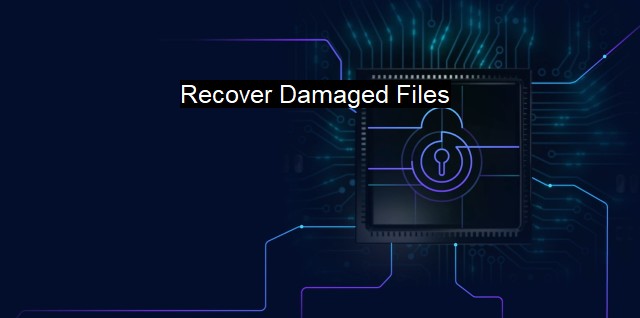What are Recover Damaged Files?
The Importance of File Recovery and Antivirus Software in Cybersecurity: Protecting Your Digital Data in Today's Era
Recovering damaged files is an important part of cybersecurity and is often necessary in situations where files have been damaged due to viruses, malware, or other types of cyber threats. This recovery is aimed at restoring or recovering these files back to their original state, before they got damaged or compromised. The process involves multiple techniques and measures, and is profoundly backed by antivirus software and other cybersecurity tools.When we talk about file damage it primarily refers to the alteration of file contents, file structure, file name or even its location. In some cases, malicious software such as worms and Trojans can encrypt files rendering them inaccessible. As such, one of the key facets in cybersecurity involves protection against these threats; but, sometimes protection might not be enough and recovery of damaged or compromised files becomes necessary.
Cabling a file as damaged demands an understanding of how the damage took place in the first place. There are clear telltale signs that denote a file as damaged: inability to open a particular file despite repeated attempts, random switch of files to read-only mode, inconsistent file properties, and inexplicable alteration of file contents. At its core, any abnormal attributes, values, or behaviors that signify deviation from a file's original version would categorically place that file under the damaged category.
Cybersecurity is often measured by the protection it provides, but the effectiveness of antivirus is gauged by both how well it provides protective measures against infections and how it plays a crucial role in recovering damaged files. Antivirus software has the power to quarantine harmful entities and repair files. Liabilities like misconstrued information or even an inoperable computing machine incurred from a virus can be mitigated by antivirus recovery tools.
Modern antivirus software is capable of creating file backups and restore points. During scans for potential threats, any signs of invasive activity or suspicious changes in files are reported. If a malicious program is found to be modifying or damaging a file, the software can block the program, revert the file back to a previous, safe version, or even use algorithms to try to revive the damaged portions of the file.
Apart from antivirus software, basic computing practices like regular data backup and system restore points also aid in the recovery of damaged files. Backups provide a safe copy of data while restore points work by capturing a snapshot of an entire system. Should any files get compromised, or a data catastrophe occurs due to virus attacks, these can be restored to their earlier versions.
The cyber world is riddled with new types of malware, trojans, and ransomware, and with the increasing threat landscape, the concept of file recovery from damages pushes to evolve alongside. Application of AI and machine learning in cybersecurity are rumored to create more advanced recovery systems. These systems, in theory, would predict the potential areas of corruption, increasing the precision and time-effectiveness of repair operations. They can even go a step further by identifying potential exploits and rectifying them before they become susceptible to attacks.
Despite the automation, the responsibility of preventing damage to files does not lie solely on antivirus and cybersecurity protocol. Regular updates of software, cautious online behavior, improvement of computer literacy, constant awareness of the types of threats, and the potential damage they could inflict are practices that every individual should keep in their armory against the increasing threats of our digital age.
The ability to recover damaged files is the next line of defense providing a safety net when preventative measures fail. Antivirus software plays a critical and multifarious role in battling cyber threats; not merely through identification and isolation but also through healing the damage caused. The complexity and vast expanse of potential threats constantly push the boundaries of recovering damaged files to become more advanced and resilient, making it an ever-evolving and mandatory facet of cybersecurity and antivirus.

Recover Damaged Files FAQs
What should I do if my antivirus detects a damaged file?
If your antivirus detects a damaged file, the first step is to quarantine the file to prevent further harm to your system. You can then attempt to recover the file using file recovery tools or by restoring from a backup.Can malware cause damage to my files?
Yes, malware can cause damage to your files by corrupting or deleting them. It is important to have proper antivirus and cybersecurity measures in place to prevent malware infections.What are some common causes of file damage?
Some common causes of file damage include hardware failures, software bugs, malware infections, and human error. It is important to regularly backup your files to prevent data loss in case of file damage.What are some file recovery tools I can use?
There are many file recovery tools available, both free and paid. Some popular options include Recuva, EaseUS Data Recovery Wizard, and Stellar Data Recovery. It is important to note that not all files can be recovered, especially if they have been overwritten or if the damage is extensive.| | A | | | B | | | C | | | D | | | E | | | F | | | G | | | H | | | I | | | J | | | K | | | L | | | M | |
| | N | | | O | | | P | | | Q | | | R | | | S | | | T | | | U | | | V | | | W | | | X | | | Y | | | Z | |
| | 1 | | | 2 | | | 3 | | | 4 | | | 7 | | | 8 | | |||||||